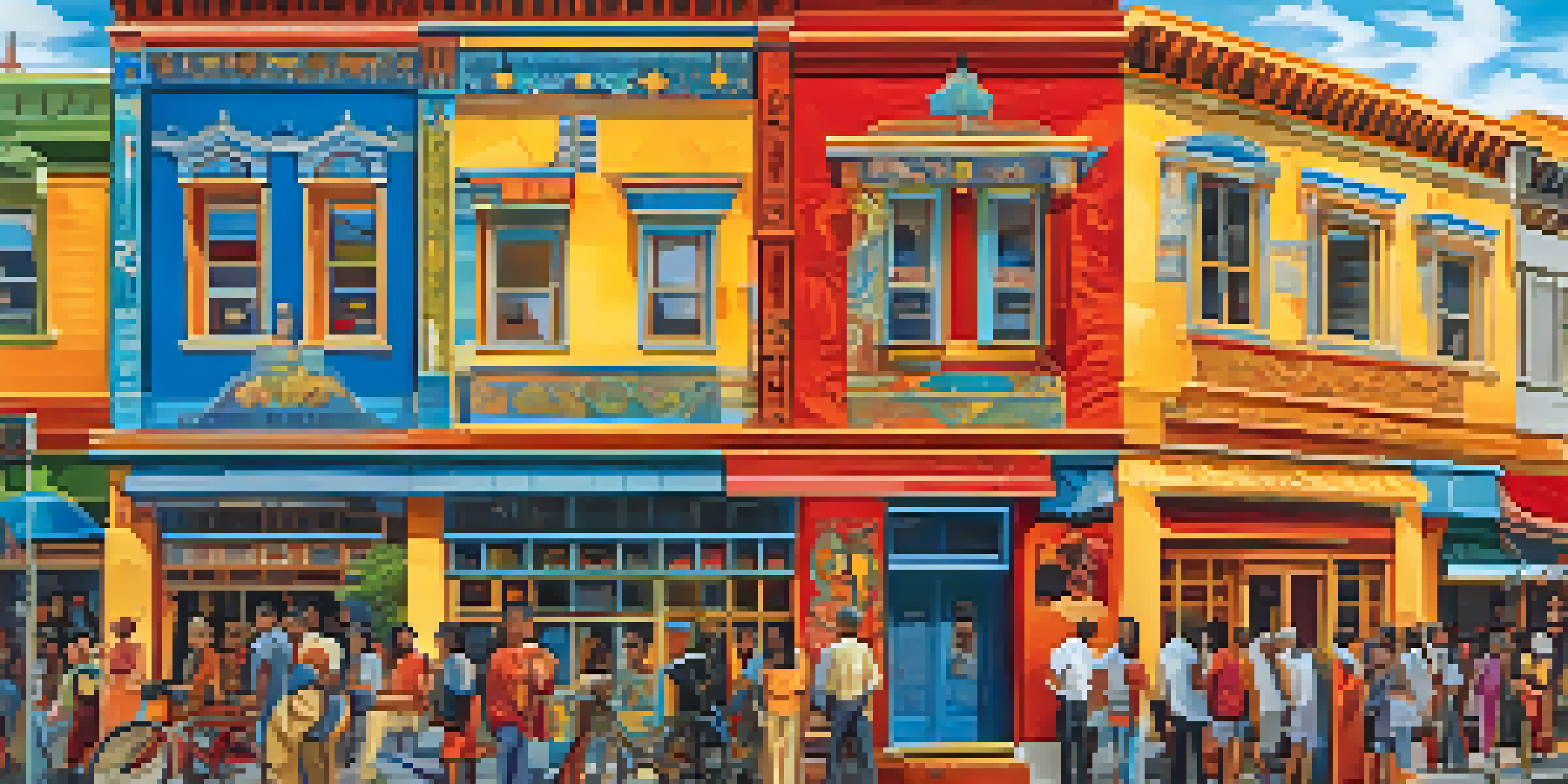Art, Myth, and Identity: The Influence of Cultural Narratives

Understanding the Role of Art in Cultural Narratives
Art serves as a powerful medium through which cultural narratives are conveyed. From ancient cave paintings to modern digital art, creative expressions reflect the values, beliefs, and stories of communities. This connection illustrates how art can encapsulate complex ideas, making them accessible to wider audiences.
Art is the most beautiful of all lies; it is a reflection of our deepest truths.
For instance, indigenous art often incorporates symbols and stories that represent a tribe's history and identity. By engaging with these artworks, one can gain insights into the cultural context and experiences of the creators. This fosters a deeper appreciation for the diversity of human experience and the narratives that shape it.
Ultimately, art not only communicates cultural narratives but also invites dialogue, encouraging individuals to reflect on their own identities. This interplay between art, culture, and identity highlights the importance of preserving artistic expressions as a means of understanding humanity.
The Significance of Myths in Shaping Identity
Myths are foundational stories that impart lessons, values, and beliefs within a culture. They often explain the origins of a community and define its identity by illustrating shared experiences and aspirations. These narratives, whether passed down orally or through written texts, play a crucial role in uniting members of a community.

Take, for example, the Greek myths that have influenced Western literature and philosophy. Characters like Hercules and Zeus not only embody certain virtues and flaws but also reflect the societal values of their time. By exploring these myths, individuals can better understand how historical narratives inform contemporary identity.
Art Reflects Cultural Narratives
Art serves as a powerful medium that encapsulates and communicates the complex stories and values of various cultures.
Moreover, myths often evolve over time, adapting to changing cultural landscapes. This adaptability ensures that they remain relevant, allowing new generations to connect with their heritage while forging their own identities.
Cultural Narratives and Their Impact on Identity Formation
Cultural narratives encompass the stories told within a society, shaping collective identities. These narratives can emerge from folklore, history, or even popular culture, influencing how individuals see themselves and their place within the world. The stories we tell and share play a crucial role in defining who we are.
Myth is much more than a story; it is a way of understanding the world and our place in it.
Consider the narrative of the American Dream, which promotes the idea that anyone can achieve success through hard work. This collective story shapes the identity of many Americans, instilling a sense of hope and ambition. However, it also highlights the disparities that exist, prompting discussions about access and equality.
By examining cultural narratives critically, we can uncover the underlying assumptions and values they perpetuate. This reflection allows individuals to navigate their identities more consciously, embracing or challenging the narratives that shape them.
Art as a Reflection of Personal and Collective Identity
Art not only reflects cultural narratives but also personal experiences. Artists often draw upon their backgrounds, emotions, and interactions to create works that resonate on multiple levels. This connection between the artist and their audience can foster a sense of shared identity and understanding.
For instance, a mural depicting a community's struggles and triumphs may evoke pride and solidarity among its members. Viewers often find their own stories reflected in the artwork, creating a powerful bond between the artist and the audience. This shared experience enhances the collective identity of the community.
Myths Shape Collective Identity
Myths are foundational narratives that define community identities by illustrating shared experiences and aspirations.
Ultimately, art serves as a bridge between personal and collective identities, allowing individuals to explore their own experiences while connecting with broader cultural narratives. This interplay enriches both the artistic process and the impact of the artwork.
The Evolution of Cultural Narratives in a Globalized World
Globalization has led to an unprecedented exchange of cultural narratives, blending traditions and perspectives. As people move, communicate, and share ideas across borders, they contribute to a dynamic tapestry of identities. This evolution poses both challenges and opportunities for how narratives are formed and understood.
For example, the fusion of various musical styles creates new genres that reflect diverse cultural influences. Artists like Shakira and BTS showcase how blending different traditions can lead to innovative expressions that resonate globally. This not only broadens the audience but also enriches the cultural narrative.
However, this blending also raises questions about cultural appropriation and the preservation of authentic voices. Navigating these complexities involves respecting original narratives while appreciating the new interpretations that emerge in a globalized context.
The Role of Storytelling in Preserving Cultural Identity
Storytelling is a fundamental way to preserve cultural identity. By passing down stories through generations, communities maintain their traditions, values, and languages. This oral tradition allows for the continual evolution of narratives while honoring the past, fostering a sense of belonging.
Think of the storytellers in Indigenous cultures, who weave history and lessons into captivating tales. These narratives not only entertain but also educate younger generations about their heritage. Through storytelling, culture is kept alive, and identity is reinforced.
Embracing Diversity Enhances Narratives
Recognizing and celebrating diverse cultural narratives fosters empathy and enriches our understanding of human identity.
In today’s digital age, storytelling has taken on new forms, from podcasts to social media. These platforms provide fresh opportunities to share cultural narratives, ensuring that they remain relevant and accessible. As stories continue to evolve, they help shape the identities of both individuals and communities.
Embracing Diversity: The Future of Cultural Narratives
As we look to the future, embracing diversity in cultural narratives becomes essential. The richness of human experience lies in our differences, and recognizing the value of various narratives can enhance our understanding of one another. This acceptance fosters empathy and cooperation among different cultures.
Initiatives that promote cultural exchange, such as art festivals and storytelling workshops, facilitate collaboration and mutual respect. These interactions allow for a deeper appreciation of diverse identities and experiences, enriching our collective narrative. By celebrating diversity, we cultivate a more inclusive society.

Ultimately, the future of cultural narratives depends on our willingness to engage with and learn from one another. By honoring various stories and perspectives, we can create a richer, more harmonious narrative that reflects the beautiful complexity of human identity.